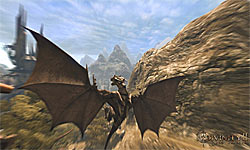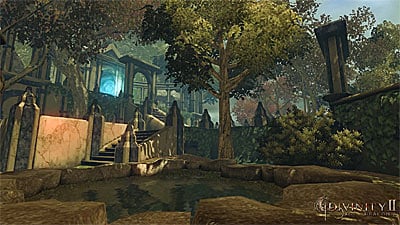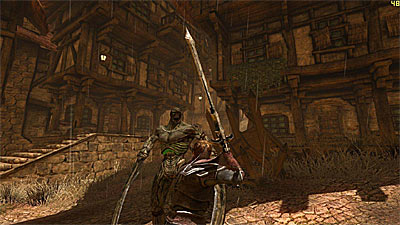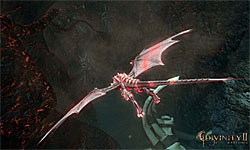The Time for Dragons is… Past
The repetitively named Divine Divinity was released as a PC-exclusive RPG eight years ago. Although the title was a minor hit, it didn’t exactly make a huge impact on the RPG genre as a whole. Still, almost a decade later, Divinity is back, and instead of a story involving a civil war spanning the globe, Divinity II sets its sights on the skies and explores the mythology of dragons as well as those who would hunt them.

You play as a self-named hero or heroine, who has just finished training to become a dragon slayer. Unfortunately, before you become a proper dragon slayer, you have to go through a mind expanding ritual where you will gain special apparition-sensing and mind-reading abilities, thanks to a Dragon-infused concoction. However, this ritual comes with one side effect… you forget all your training (total burn!) But nevermind your lack of skills, there are dragons running loose out there, and it’s your job to stop them. That is until you find yourself turning into a dragon yourself, due to some negligence on the part of those who are supposed to be looking out for you.
The story is certainly conducive to the RPG format and allows for plenty of character growth. However, I couldn’t help but feel like it was a little bit hollow. Once the “twist” happens at the beginning, you are left with a whole lot of dialogue reiterating things you know already. Throw in some stock characters and classic fantasy tropes, and you’ve got a story that you probably know all about before even inserting the disc.
The formulaic story is certainly disappointing, but it is far from the worst facet of this game. That honor belongs to the visuals. Not since The Last Remnant have I seen an RPG that gets the technicalities as wrong as Divinity II. Right from the opening cutscene, you’ll notice plenty of framerate inconsistencies, chugging, and awkward animation. And that’s just the beginning. Screen-tears and pop-in are constant throughout the game as well, and the poor visuals really detract from the overall experience of the game. Though there were no game-breaking glitches (at least that I encountered), the chugging and framerate issues can hinder you in battle, which can lead to some serious frustration.

In addition to the visuals, I was also disappointed by the game’s level-up and progression system. Current-generation RPGs like Dragon Age: Origins and Fable II have done a great job of sprucing up the old RPG formula with targeted leveling and diverse abilities, but Divinity II takes the exact opposite approach. Instead of branching abilities and levels, Divinity II has very linear leveling with an exclusive three-class system that locks you into one class with a specific leveling path. Although you can switch your classes, doing so is very cumbersome, and the game doesn’t afford you many luxuries if you decide to switch mid-game from archer to warrior.
The battle system itself is not too terrible. You’ll start out with a standard and special attack, each activated by pressing the face button correlated with the attack. The battle system is active, meaning you’ll have to engage in a bit of button-mashing during battles. However, the catch is that unless you are using standard melee, there is a time limit for each attack. So, if for instance you have a charged sword attack equipped, you’ll have to wait 3-4 seconds in between uses. Although the game tries to use this to help you develop a tactical strategy that doesn’t include mashing buttons. However, the trouble is that this system actually makes the combat feel really slow, and you’ll have to do a lot of jumping to avoid enemy attacks while you are waiting to use an attack that is not melee.

In addition to the slow combat, battle also suffers from an awkward targeting system. Instead of using an active system that targets enemies as they come towards you, you have to line up an on-screen reticule (which is fixed in the center of the screen) with your enemies in order to attack them.
This part of the battle system feels the most antiquated, and it is far too time-consuming to line up enemies with your reticule just to have them dodge out of the way at the last moment. Although this is less of an issue in the dragon-fighting portions of the game, when you play as a human, lining up your attacks can be incredibly frustrating and definitely lost me a fair share of battles

The only facet of the game that didn’t strike me as sub-par or antiquated was the sound. The game, despite its simplistic storyline, features an uncannily large roster of NPCs, each one with plenty of things to say. The voice acting is very well done, and while some of the NPCs sound a little wooden here and there, I was extremely pleased with the overall breadth of the voice acting in this title. The background music wasn’t as impressive as the voiceover, and did get repetitive in parts, but it was mostly inoffensive overall.
Although the game doesn’t have many redeeming qualities, I do have to say that none of these poor aspects is an absolute deal-breaker. Sure, the game looks bad, and the battle system is yawn-worthy, but if you have finished every other RPG out there, you may find some enjoyment from Divinity II. It really can’t compare with the likes of Dragon Age: Origins or the Elder Scrolls series, but it is at least playable. Just make sure you have exhausted all other options before picking this title up, and definitely don’t get your hopes up for anything awesome or genre-defining. The only thing that is really surprising about Divinity II is why it took them eight years to make such an average sequel.
RATING OUT OF 5 RATING DESCRIPTION 2.0 Graphics
Technical glitches abound, including frequent seaming, tearing, and constant framerate inconsistencies. 3.0 Control
Controls for the dragon form are fine, but battle with the human form (where you’ll spend most of your time) feel antiquated. 3.6 Music / Sound FX / Voice Acting
Music is a little forgettable, but the voice over cast does an excellent job of bringing the world of Divinity II to life. 3.5 Play Value
There is plenty to do in Divinity II, and if you don’t mind putting up with the poor visuals or combat, there are plenty of side-quests to take on to extend your experience. 2.8 Overall Rating – Average
Not an average. See Rating legend above for a final score breakdown.
Game Features:
